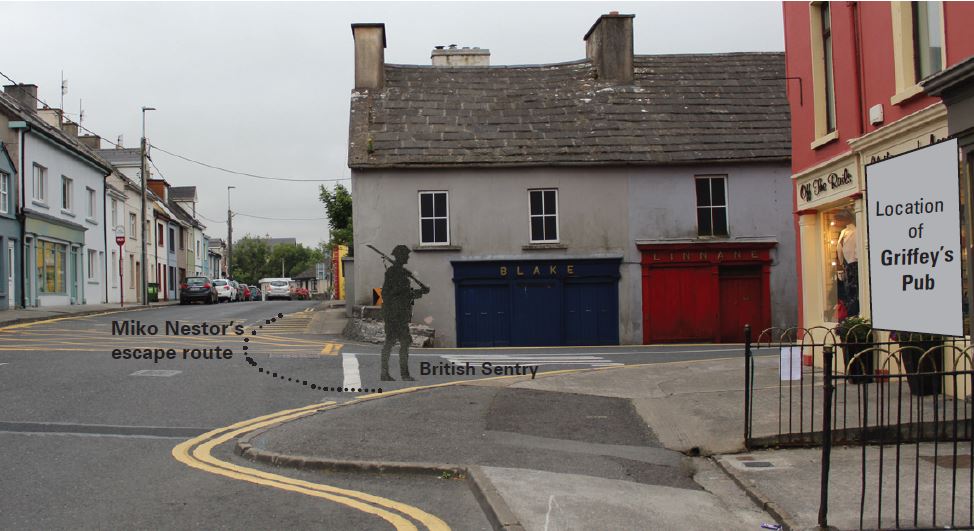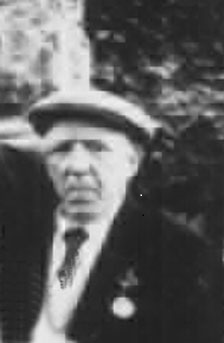Miko Nestor seizes rifle from British Soldier
ON JULY 8th 1920 MIKO NESTOR SEIZES RIFLE FROM BRITISH SOLDIER
IN ENNISTYMON
A scarcity of arms and ammunition was a constant issue for the Mid Clare Brigade throughout the War of Independence as they faced the overwhelming strength of the Crown Forces. In the summer of 1920, Seamus McMahon of Ennistymon company described the formidable odds that the Volunteers had to face.
“When the smaller R.I.C. stations were evacuated early in 1920, the men in Kilfenora, Maurice’s Mills and Lahinch were withdrawn to Ennistymon and by Easter of that year, there were around thirty-five RIC police stationed in the town. In addition to this force, there was a military garrison of about 200 men in the Workhouse. With the advent of the Black and Tans, the enemy strength was further increased by about thirty-five. The Black and Tans took over the Courthouse.
The total equipment of the Ennistymon Company of the Irish Volunteers at the commencement of 1919 consisted of about four revolvers, a dozen shotguns and six rifles. The revolvers were of the British bulldog variety and were old. The shotguns were obtained mostly from friendly sympathisers in the district or through raids on the houses of people who were loyalists or indifferent to the Sinn Féin movement. Three rifles were of the Martin Henry type and three were service rifles obtained from British soldiers home on leave from the First World War. The majority of the Volunteers in Ennistymon had received very little instruction in the use of fire-arms even up to the Truce, and it can be said that not more than twenty men from the Company were ever asked to participate in any form of military activity other than foot and extended order drill, parades, scouting, road cutting and despatch carrying. This is not stated by way of any form of reflection on the big majority of the Company; there was not sufficient arms available for all the men and naturally, whenever an attack or raid was planned on the enemy, the men who were considered best, were selected”.
This appraisal of the scarcity of weapons could be applied to any of the Companies in the 4th and 5th Battalion areas and it was only daring attacks on police and army patrols, by Volunteers in both Battalions, that yielded the weaponry to carry on the fight. However, another important weapon at the disposal of the Volunteers was the public support they enjoyed and the abhorrence most people had for the police, as evidenced by the RIC County Inspector in June 1920 who stated:
“The feeling against the police in some areas runs very high and in no places can they obtain any transport nor get repairs to barracks done. This form of boycotting is growing but in most places food and other necessities are freely sold to them”.
John Joe “Tosser” Neylon, Captain of Ennistymon Company was ‘on the run’ in 1920 and had to be cautious about his movements. He was in Ennistymon on 8th July calling to the house of a friend called Minnie Healy:
“I was standing at the door I saw two soldiers on sentry duty at Ennistymon Bridge near Blake’s corner. They were armed with two rifles. I thought this was a grand chance of seizing the rifles. I made up my mind at once and decided that if one of the soldiers could be got away for a drink, it would be easy for a couple of men to attack the other soldier and capture the guns. Seamus Conneally accidentally came along at the time and I suggested that he should invite one of the soldiers into Nicholas Griffey’s Pub near the bridge”.
Seamus Conneally, another Volunteer leader, takes up the story:
“I agreed and walked towards the bridge near where I met three volunteers from the town, Michael (Miko) Nestor, Peter Monaghan, and Michael Healy, all of whom were conversant with the plan. I went over to the soldiers and got into friendly conversation with them. After a while, I suggested having a drink. One of them came with me into Griffey’s public house. He left his rifle with the other soldier.
As we were having the drink we heard shouting outside. The soldier tried to rush out but I prevented him from doing so by shutting the door. The publican and some other people who were in the bar began to protest and after some minutes I released the soldier”.
Meanwhile, Miko Nestor and Miko Healy had begun the attack, which Nestor later described:
“I seized my man and took his rifle after a severe struggle. At the same moment, the second soldier came on the scene, took the rifle which the other Volunteer failed to bring, and began firing at me while I was running with my seized rifle. I succeeded in escaping though as many as 7 or 8 shots were fired after me”.
Miko Nestor made good his escape by running up the New Road and entering one of the houses and according to Tosser Neylon:
“He managed to hide the rifle which he had taken, in Nurse McElwee’s yard. That night he and I retrieved the rifle, hiding it out in Healy’s Mountain outside the town and remained the night there in an old hut”.
Extract from North Clare’s Fight for Irish Freedom, newly published book by Colm Hayes, now available in bookshops.

